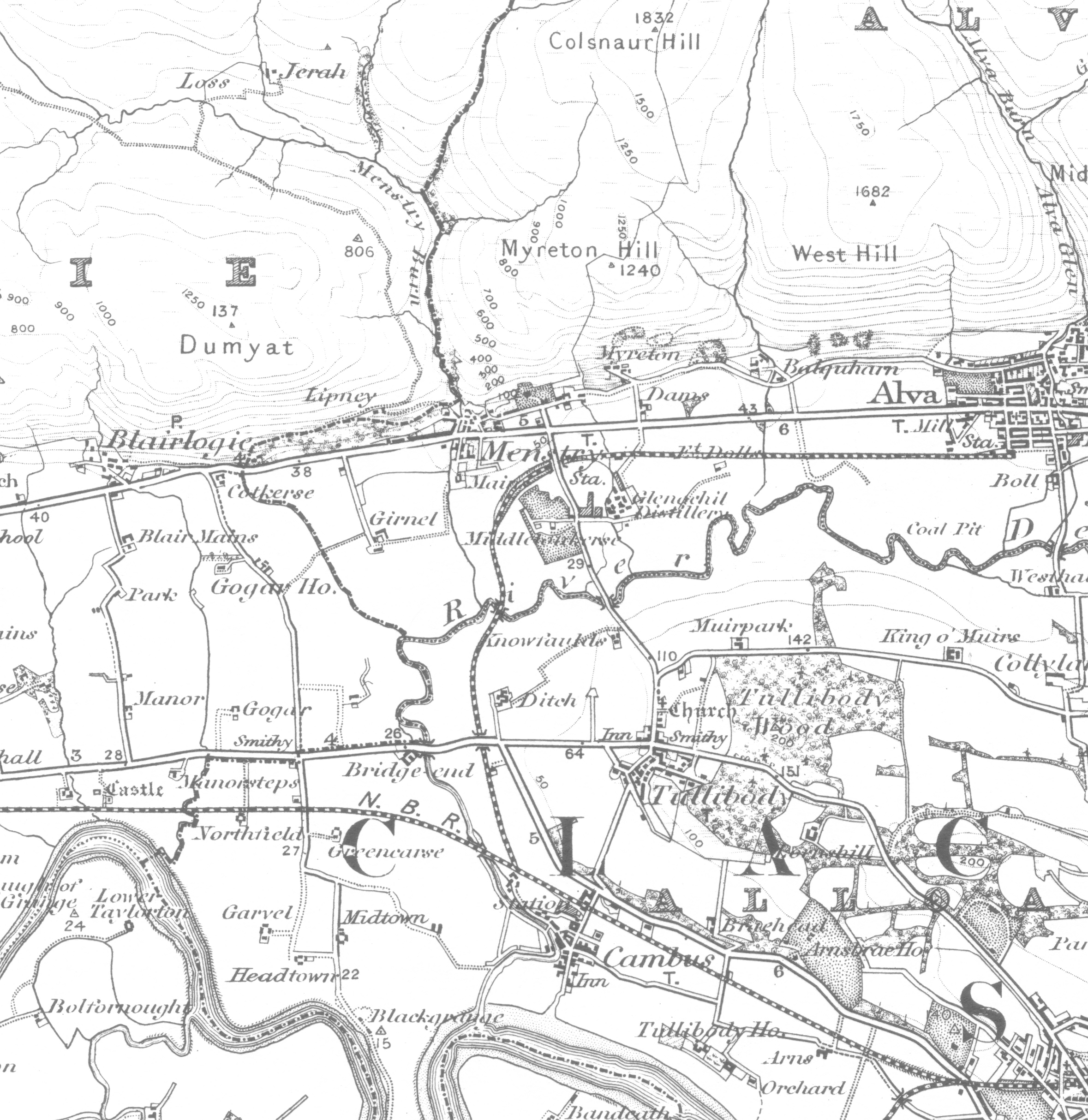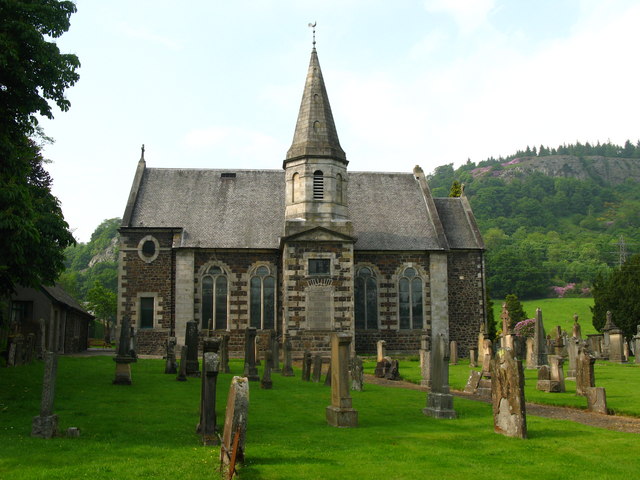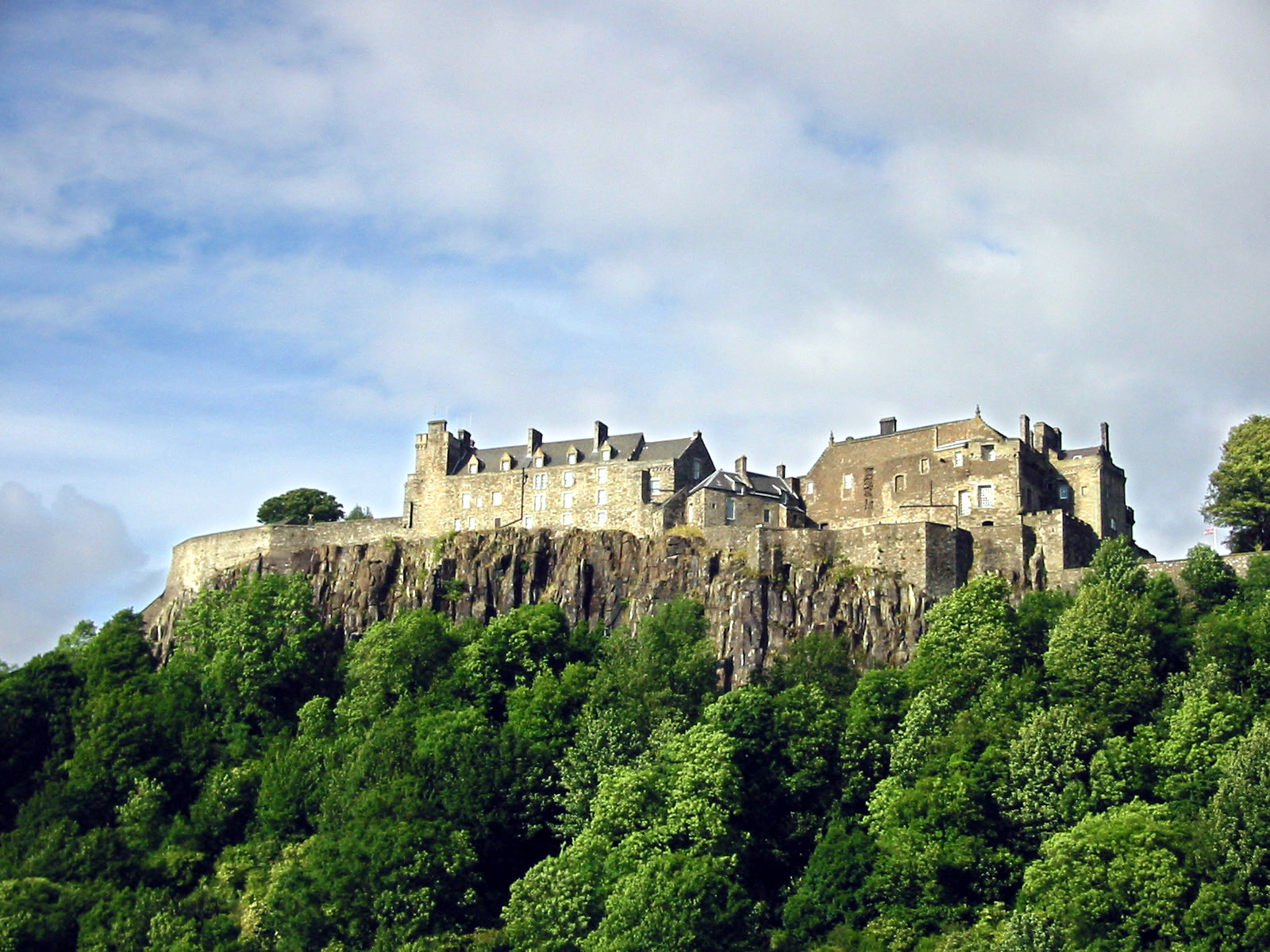|
Blairlogie
Blairlogie is a village in the Stirling council area of Scotland, situated at the base of the great southern rock-face of Dumyat between Stirling and Menstrie. Blairlogie, formerly Blair, forms part of Logie parish, formerly in Perthshire, and the ancient Logie Kirk lies to the west. It comprises mainly 17th-19th century cottages and was one of central Scotland's earliest Conservation areas, designated in 1969. At the foot of Castle Law (and giving its name to the hill) stands Blairlogie Castle (also known as "The Blair"), built in 1543 by Alexander Spittal. The castle and surrounding estate was purchased by Lt Col Hare of Calder Hall in 1891 who modernised it. An abandoned copper mine lies to the east of the village. Between 1598 and 1609, the minister of Logie Kirk was the poet Alexander Hume Alexander Hume (1558 – 4 December 1609) was a Scottish poet who served as Moderator of the General Assembly of the Church of Scotland in the early 17th century. Life He was ... [...More Info...] [...Related Items...] OR: [Wikipedia] [Google] [Baidu] |
Blairlogie Castle
Blairlogie Castle (in Scottish Gaelic: ''Caisteil Blàr Lagaidh''), also known as "The Blair", stands in its grounds near the village of Blairlogie in Stirling in Scotland, one of Scotland's earliest conservation villages, consisting of a cluster of 17th-19th-century cottages. The castle commands a strategic position at the southern end of the Ochil Hills on the Northeastern approach into the ancient Scottish capital of Stirling. It sits at the base of the cliff of Dumyat, and at the foot of Castlelaw, overlooking the National Wallace Monument. The castle is a category A listed building and was listed in 1973. History The lands of the Blairlogie estate were held by the Scottish Crown until 1513, when James IV James IV (17 March 1473 – 9 September 1513) was King of Scotland from 11 June 1488 until his death at the Battle of Flodden in 1513. He inherited the throne at the age of fifteen on the death of his father, James III, at the Battle of Sauch ... granted them to a ... [...More Info...] [...Related Items...] OR: [Wikipedia] [Google] [Baidu] |
Menstrie
Menstrie (Scottish Gaelic: ) is a village in the county of Clackmannanshire in Scotland. It is about east-northeast of Stirling and is one of a string of towns that, because of their location at the foothill base of the Ochil Hills, are collectively referred to as the Hillfoots Villages or simply ''The Hillfoots''. Etymology The name ''Menstrie'', recorded as ''Mestreth'' and ''Mestryn'' in the 1260s, is of Pictish origin. The name is composed of elements cognate to Welsh , meaning 'field, plain', and , 'town, village, farm'. Physical geography Menstrie stands on the carse or flood plain of the River Devon, between 10 and 20 metres altitude above sea level. It is roughly astride the Ochil Fault whose movement gave rise to the dramatic southern scarp of the Ochils but which is now almost quiescent. Two of the most westerly summits of the Ochil Hills, Dumyat and Myreton Hill, rise steeply to the north of the village to reach about 400m altitude. These two hills are divided ... [...More Info...] [...Related Items...] OR: [Wikipedia] [Google] [Baidu] |
Stirling (council Area)
The Stirling council area (; ) is one of the 32 council areas of Scotland, and has an estimated population of (). It was created in 1975 as a lower-tier districts of Scotland, district within the Central Region, Scotland, Central Regions and districts of Scotland, region. The district covered parts of the Shires of Scotland, historic counties of Stirlingshire and Perthshire, which were abolished for local government purposes. In 1996 the Central region was abolished and Stirling Council took over all local government functions within the area. The administrative centre of the area is the city of Stirling, with the headquarters at Old Viewforth. The area borders the council areas of Clackmannanshire (to the east), North Lanarkshire (to the south), Falkirk (council area), Falkirk (to the south east), Perth and Kinross (to the north and north east), Argyll and Bute (to the north and north west), and both East Dunbartonshire, East and West Dunbartonshire to Stirling's southwest. ... [...More Info...] [...Related Items...] OR: [Wikipedia] [Google] [Baidu] |
Logie Kirk
Logie Kirk, considered something of a ‘hidden gem, is nestled in a tranquil spot beneath Dumyat at the Western side of the Ochil Hills, east of Stirling in central Scotland. It serves Church of Scotland pastoral duties in the areas of Cambuskenneth, Bridge of Allan, Causewayhead (eastern Stirling), and formerly the estate of Airthrey Castle (now the grounds of Stirling University). The church lies on the B998 close to the junction with the A91, between Stirling and Menstrie, or more accurately between the Wallace Monument and Blairlogie. Old Kirk The church is one of the oldest Christian sites in Scotland, being established during the reign of King David I of Scotland (between 1124 and 1153). A church was built here by ay least 1183 and local tradition suggests it was dedicated to St Serf. There are indications of an older Christian establishment: there are up to four 10th/11th century hogbacks in the cemetery. The church was rebuilt in 1380 and survived in use until after the ... [...More Info...] [...Related Items...] OR: [Wikipedia] [Google] [Baidu] |
Hillfoots Villages
The Hillfoots Villages are the villages and small towns which lie at the base of the southern scarp face of the Ochil Hills, formed by the Ochil Fault, in Stirlingshire and Clackmannanshire in central Scotland. From west to east the communities are Blairlogie, Menstrie, Alva, Tillicoultry, Devonside, Coalsnaughton, Dollar Dollar is the name of more than 25 currencies. The United States dollar, named after the international currency known as the Spanish dollar, was established in 1792 and is the first so named that still survives. Others include the Australian d ... and Muckhart. External links Hillfoots Villages Map*Satellite image showing all the Hillfoots Villages - Google Maps {{authority control Villages in Stirling (council area) Villages in Clackmannanshire ... [...More Info...] [...Related Items...] OR: [Wikipedia] [Google] [Baidu] |
Kenny Logan
Kenneth McKerrow Logan (born 3 April 1972) is a Scottish retired rugby union player who played wing (rugby union), wing for Stirling County RFC and Glasgow District (rugby union), Glasgow District at amateur level; Glasgow Warriors, Wasps RFC professional level; and Scotland national rugby union team, Scotland at international level. He won three English Premiership (rugby union), English Premierships Heineken Cup with Wasps RFC; and one Scottish Premiership title with Stirling County RFC in 1995, just before the game turned professional. Early life Logan was born on 3 April 1972 in Stirling, Scotland. As a schoolboy, Logan had Association football, football trials as a Goalkeeper (association football), goalkeeper for Dundee United F.C., Dundee United and Heart of Midlothian F.C., Hearts. He left school at sixteen and began his rugby career with his hometown club Stirling County RFC, Stirling County, making his senior debut at 17. Club career Logan played for the amate ... [...More Info...] [...Related Items...] OR: [Wikipedia] [Google] [Baidu] |
Alexander Hume
Alexander Hume (1558 – 4 December 1609) was a Scottish poet who served as Moderator of the General Assembly of the Church of Scotland in the early 17th century. Life He was born in 1558 the son of Patrick Hume (d.1599). The brother of Patrick Hume of Polwarth, he was educated at the University of St. Andrews graduating in 1574 then studied Civil Law in Paris. He returned to Scotland in 1578 serving in the Court of Justice, but (ironically) found it too corrupt for his tastes and decided instead to devote himself to the service of the church, and became minister of Logie Kirk in Stirlingshire in 1597. This appears to have been at least partly supported by Alexander Home of North Berwick, Provost of Edinburgh. His stipend (or at least the bulk of it) appears to have been paid by his own father rather than by the church. His manse stood to the west of the church in the grounds of Airthrey Castle and dated from 1590. He served as Moderator of the General Assembly of the Chu ... [...More Info...] [...Related Items...] OR: [Wikipedia] [Google] [Baidu] |
Old Drovers Path At Cotkerse
Old or OLD may refer to: Places *Old, Baranya, Hungary *Old, Northamptonshire, England *Old Street station, a railway and tube station in London (station code OLD) *OLD, IATA code for Old Town Municipal Airport and Seaplane Base, Old Town, Maine, United States People *Old (surname) Music *OLD (band), a grindcore/industrial metal group * ''Old'' (Danny Brown album), a 2013 album by Danny Brown * ''Old'' (Starflyer 59 album), a 2003 album by Starflyer 59 * "Old" (song), a 1995 song by Machine Head *"Old", a 1982 song by Dexys Midnight Runners from ''Too-Rye-Ay'' Other uses * ''Old'' (film), a 2021 American thriller film *''Oxford Latin Dictionary'' *Online dating *Over-Locknut Distance (or Dimension), a measurement of a bicycle wheel and frame See also *Old age *List of people known as the Old *''Old LP'', a 2019 album by That Dog * * *Olde, a list of people with the surname *Olds (other) Olds may refer to: People * The olds, a jocular and irreverent online nick ... [...More Info...] [...Related Items...] OR: [Wikipedia] [Google] [Baidu] |
Conservation Area (United Kingdom)
In the United Kingdom, the term conservation area almost always applies to an area (usually urban or the core of a village) of special architectural or historic interest, the character of which is considered worthy of preservation or enhancement. It creates a precautionary approach to the loss or alteration of buildings and/or trees, thus it has some of the legislative and policy characteristics of listed buildings and tree preservation orders. The concept was introduced in 1967, and by 2017 almost 9,800 had been designated in England. 2.2% of England making up is a conservation area, 59% of which are rural, and 41% are in urban areas. History The original idea of historic conservation areas was proposed by June Hargreaves, a York town planner, in her 1964 book ''Historic buildings. Problems of their preservation''. In the book she critiqued the idea that historic buildings should be replaced with modern "streamlined and ultra-functional" buildings as this would be detrimen ... [...More Info...] [...Related Items...] OR: [Wikipedia] [Google] [Baidu] |
Stirling Council
Stirling (; ; ) is a city in central Scotland, northeast of Glasgow and north-west of Edinburgh. The market town, surrounded by rich farmland, grew up connecting the royal citadel, the medieval old town with its merchants and tradesmen, the Old Bridge and the port. Located on the River Forth, Stirling is the administrative centre for the Stirling council area, and is traditionally the county town and historic county of Stirlingshire. Stirling's key position as the lowest bridging point of the River Forth before it broadens towards the Firth of Forth made it a focal point for travel north or south. It has been said that "Stirling, like a huge brooch clasps Highlands and Lowlands together". The city's status as "Gateway to the Highlands" also historically lent it great strategic importance—the credo "he who holds Stirling, holds Scotland" is sometimes attributed to Robert the Bruce. When Stirling was temporarily under Anglo-Saxon sway, according to a 9th-century legend, ... [...More Info...] [...Related Items...] OR: [Wikipedia] [Google] [Baidu] |
Dumyat
Dumyat or Dunmyat (Scottish Gaelic: Dùn Mhèad) is a hill at the western extremity of the Ochil Hills in central Scotland. The name is thought to originate from ''Dun'' (hill fort) ''of the Maeatae''. Although relatively small (its height is 418 metres), the characteristic shape of the hill forms an important part of the distinctive scenery of the Stirling area, and it is often depicted (particularly in postcards and calendars) in combination with the nearby Abbey Craig. The hill is a popular climb with tourists and visitors to the Stirling and Trossachs area, due to the historical nature of Stirling and the proximity of the Wallace Monument. Dumyat has two principal summits: Castle Law on the west, and Dumyat proper on the east. On the summit of Castle Law the remains of an ancient hill fort, originally occupied by the Maeatae, are still clearly discernible. The fort is a scheduled monument. The fort has been subject to excavation by Dr Murray Cook and Professor G ... [...More Info...] [...Related Items...] OR: [Wikipedia] [Google] [Baidu] |





